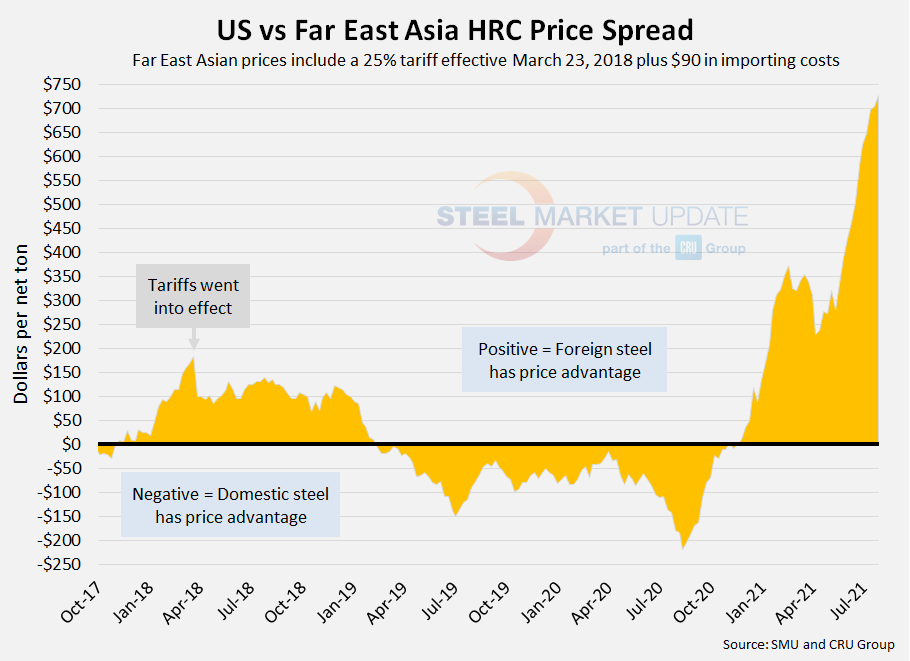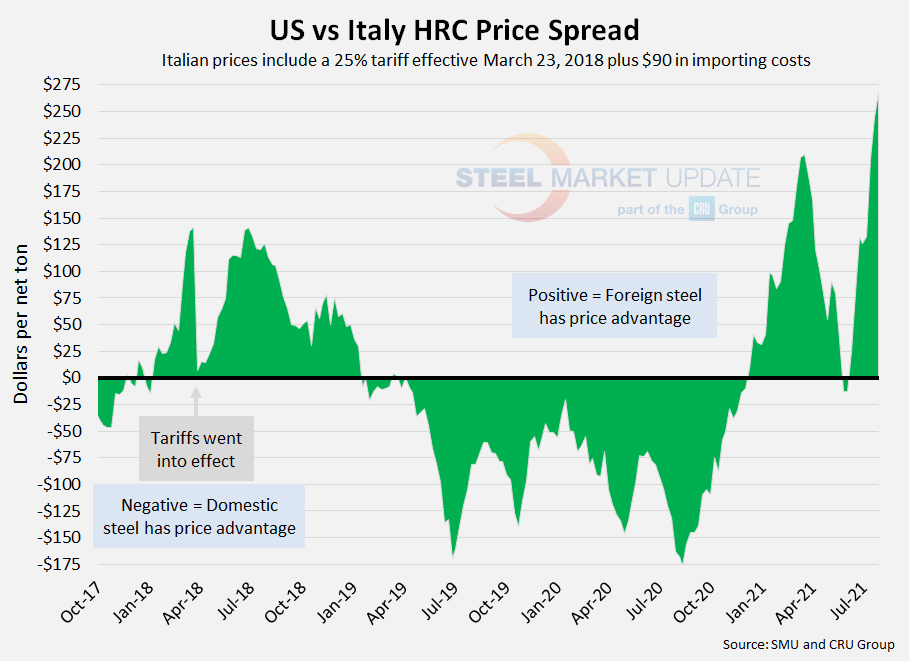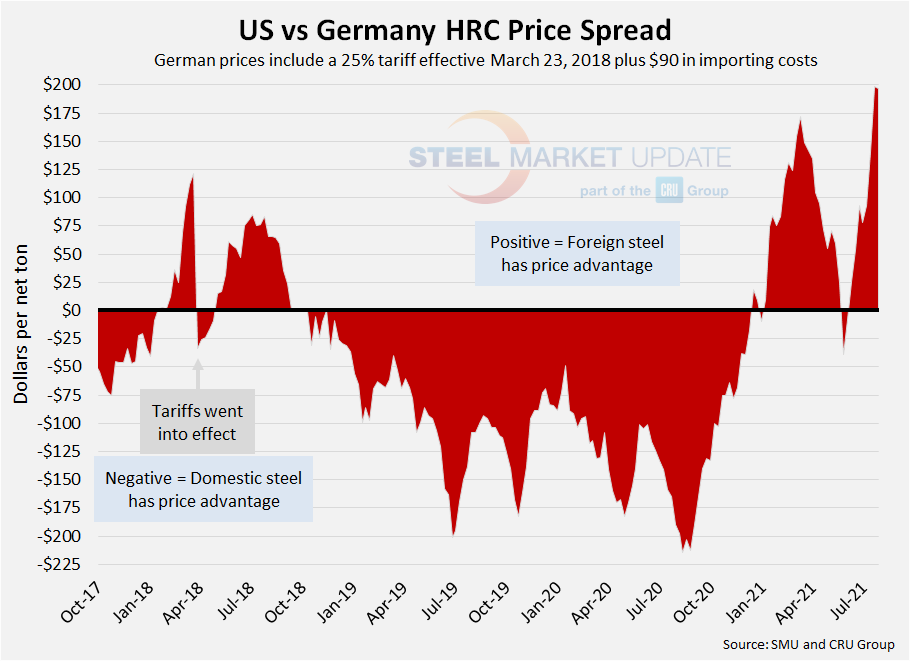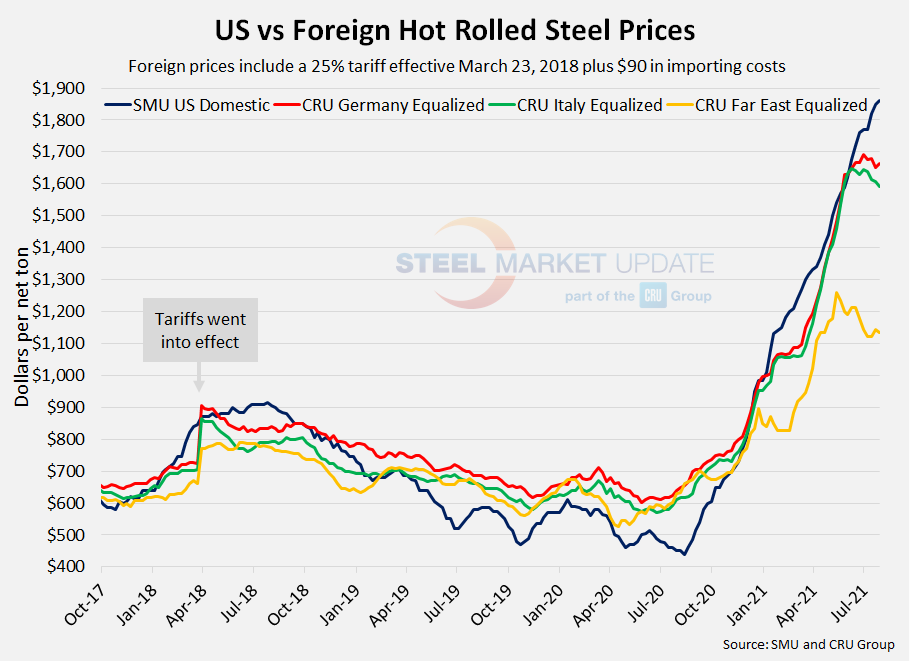International Steel Prices

Foreign vs Domestic HRC Prices: Foreign Holds $200/ton+ Potential Savings
Written by Brett Linton
July 29, 2021
The incentive to purchase hot rolled steel imports over steel produced domestically continues to grow, according to Steel Market Update’s latest foreign versus domestic hot rolled steel price comparison. As domestic prices soar higher, foreign prices are flat or declining, holding potential discounts of 11% to 27% after taking freight costs, trader margins and tariffs into consideration. Foreign HRC prices are theoretically $197-727 per ton cheaper than domestic steel prices at this time. The spread between domestic and foreign prices has surged since late-May, surpassing the record levels seen earlier this year.
The following calculation is used by Steel Market Update to identify the theoretical spread between foreign hot rolled steel prices (delivered to U.S. ports) and domestic hot rolled coil prices (FOB domestic mills). This is only a “theoretical” calculation as freight costs, trader margins and other costs can fluctuate, ultimately influencing the true market spread. This compares the SMU U.S. hot rolled weekly index to CRU hot rolled weekly indices for Germany, Italy and Far East Asian ports.
![]() SMU includes a 25% import tariff effective on foreign prices after March 23, 2018. We then add $90 per ton to the foreign prices in consideration of freight costs, handling, trader margin, etc., to provide an approximate “CIF U.S. ports price” that can be compared against the SMU U.S. hot rolled price. Note that we do not include any antidumping (AD) or countervailing duties (CVD) in this analysis.
SMU includes a 25% import tariff effective on foreign prices after March 23, 2018. We then add $90 per ton to the foreign prices in consideration of freight costs, handling, trader margin, etc., to provide an approximate “CIF U.S. ports price” that can be compared against the SMU U.S. hot rolled price. Note that we do not include any antidumping (AD) or countervailing duties (CVD) in this analysis.
Far East Asian HRC (East and Southeast Ports)
As of Wednesday, July 28, the CRU Far East Asian HRC price had declined $9 from the previous week to $835 per net ton ($920 per metric ton), up $9 per ton from two weeks prior. Adding tariffs and import costs, the delivered price of Far East Asian HRC to the U.S. is $1,133 per ton. The latest SMU hot rolled price average is $1,860 per ton, up $10 over last week and up $40 from two weeks prior. Therefore, U.S.-produced HRC theoretically is now $727 per ton more expensive than imported Far East Asian HRC, up from $705 last week, and up from $698 two weeks ago. This is now the largest theoretical spread between Far East Asian and domestic HRC prices in SMU’s four-year history (we have seen a new record spread each of the last 10 weeks). Prior to 2021, the previous record high was $183 per ton in March 2018.

Italian HRC
CRU published Italian HRC prices at $1,201 per net ton ($1,324 per metric ton), down $11 from last week, and down $17 from two weeks ago. After adding tariffs and import costs, the delivered price of Italian HRC is approximately $1,592 per ton. Accordingly, domestic HRC is theoretically $268 per ton more expensive than imported Italian HRC, up from $244 the week prior, and up from $206 two weeks ago. This is now the largest price spread in our history (we have seen a new record spread each of the last two weeks), surpassing the previous high of $210 per ton seen in mid-March 2021. Prior to 2021, the previous record high was $143 per ton in July 2016. Recall that in late-May/early-June, Italian HRC briefly lost its price advantage over domestic steel for two weeks.

German HRC
The latest CRU German HRC price is $1,258 per net ton ($1,387 per metric ton), up $9 from last week, but down $13 from two weeks ago. After adding tariffs and import costs, the delivered price of German HRC is approximately $1,663 per ton. Accordingly, domestic HRC is theoretically $197 per ton more expensive than imported German HRC, down from $199 last week, but up from $141 two weeks ago. Last week we reached the largest price spread in our history at $199 per ton, surpassing the previous high of $172 seen in mid-March 2021. Prior to 2021, the previous record high was $121 per ton in March 2018. Like Italian HRC, German HRC briefly lost its price advantage over domestic steel for two weeks in late-May/early-June.

The graph below compares all four price indices and highlights the effective date of the tariffs. Foreign prices are referred to as “equalized,” meaning they have been adjusted to include tariffs and importing costs for a like-for-like comparison against the U.S. price.

Note: Freight is an important part of the final determination on whether to import foreign steel or buy from a domestic mill supplier. Domestic prices are referenced as FOB the producing mill, while foreign prices are FOB the Port (Houston, NOLA, Savannah, Los Angeles, Camden, etc.). Inland freight, from either a domestic mill or from the port, can dramatically impact the competitiveness of both domestic and foreign steel. When considering lead times, a buyer must take into consideration the momentum of pricing both domestically and in the world markets. In most circumstances (but not all), domestic steel will deliver faster than foreign steel ordered on the same day.
By Brett Linton, Brett@SteelMarkeUpdate.com

Brett Linton
Read more from Brett LintonLatest in International Steel Prices

US and offshore HRC prices tick lower
The threat of tariffs over the past two months has been a springboard for US prices. But the Section 232 reinstatement on March 13 narrowed the domestic premium over imports on a landed basis.

Domestic CRC prices surge ahead of imports
The price spread between stateside-produced CR and imports reached its widest margin in over a year.

US HR prices rising faster than offshore tags
Hot-rolled (HR) coil prices continued to rally in the US this week, quickly outpacing price gains seen abroad. The result: US hot band prices have grown widely more expensive than imports on a landed basis. The premium US HR tags carry over HR prices abroad now stands at a 14-month high. SMU’s average domestic HR […]

US HR price premium over imports widens
Hot-rolled (HR) coil prices were flat in the US this week, while tags in offshore markets were mostly down.

US HR price premium over imports edges up
The price premium between stateside hot band and landed imports widened slightly this week.
